1998 PONTIAC BONNEVILLE torque
[x] Cancel search: torquePage 89 of 395
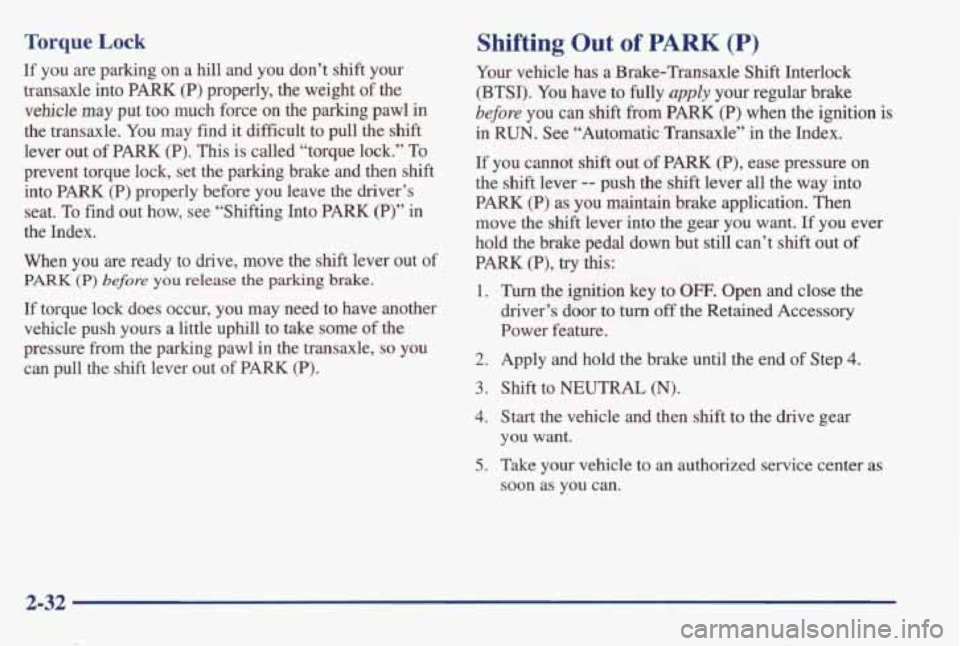
Torque Lock
If you are parking on a hill and you don’t shift your
transaxle into
PARK (P) properly, the weight of the
vehicle may put too much force on the parking pawl in
the transaxle. You may find it difficult to pull the
shift
lever out of PARK (P). This is called “torque lock.” To
prevent torque lock, set the parking brake and then shift
into
PARK (P) properly before you leave the driver’s
seat.
To find out how, see “Shifting Into PARK (P)” in
the Index.
When you are ready to drive, move the shift lever out of
PARK (P) before you release the parking brake.
If torque lock does occur, you may need to have another
vehicle push yours a little uphill to take some of the
pressure from the parking pawl in the transaxle,
so you
can pull the shift lever out of PARK
(P).
Shifting Out of PARK (P)
Your vehicle has a Brake-Transaxle Shift Interlock
(BTSI). You have to fully apply your regular brake
before you can shift from PARK (P) when the ignition is
in
RUN. See “Automatic Transaxle” in the Index.
If you cannot
shift out of PARK (P), ease pressure on
the
shift lever -- push the shift lever all the way into
PARK (P) as you maintain brake application. Then
move
the shift lever into the gear you want. If you ever
hold the brake pedal down but still can’t shift out of
PARK (P), try this:
1. Turn the ignition key to OFF. Open and close the
driver’s door
to turn off the Retained Accessory
Power feature.
2. Apply and hold the brake until the end of Step 4.
3. Shift to NEUTRAL (N).
4. Start the vehicle and then shift to the drive gear
you want.
5. Take your vehicle to an authorized service center as
soon as you can.
2-32
Page 246 of 395
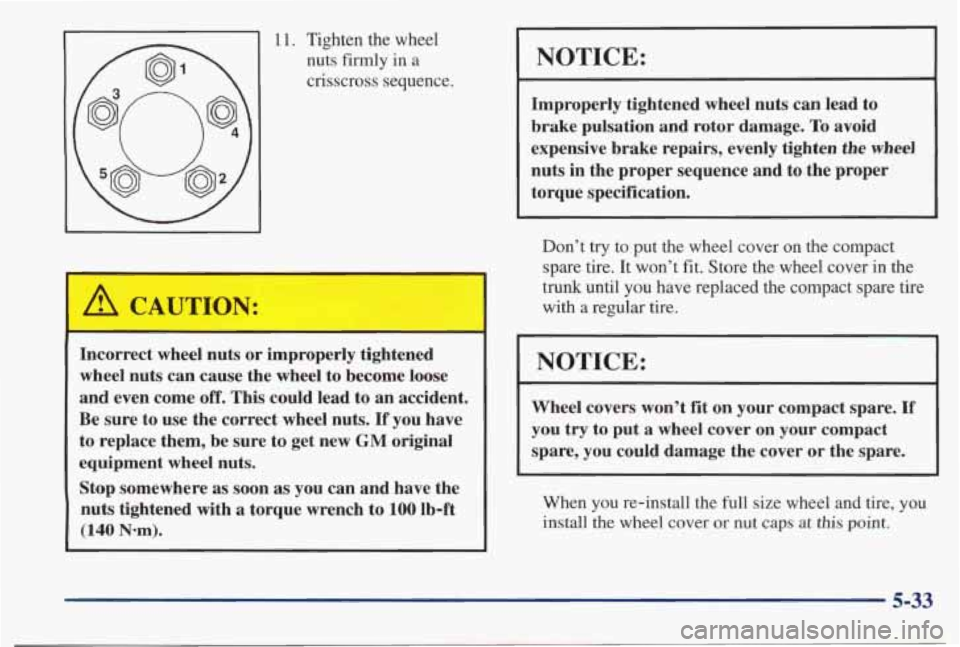
11. Tighten the wheel nuts firmly in a
crisscross sequence.
Incorrect wheel nuts or improperly tightened
wheel nuts can cause the wheel to become loose
and even come
off. This could lead to an accident.
Be sure to use the correct wheel nuts. If you have
to replace them, be sure to get new
GM original
equipment wheel nuts.
Stop somewhere
as soon as you can and have the
nuts tightened with
a torque wrench to 100 lb-ft
(140 Nom).
NOTICE:
Improperly tightened wheel nuts can lead to
brake pulsation and rotor damage.
To avoid
expensive brake repairs, evenly tighten the wheel
nuts in the proper sequence and to the proper
torque specification.
Don’t try to put the wheel cover on the compact
spare tire. It won’t fit. Store the wheel cover in the
trunk until
you have replaced the compact spare tire
with a regular tire.
NOTICE:
Wheel covers won’t fit on your compact spare. If
you try to put a wheel cover on your compact
spare, you could damage the cover or the spare.
When you re-install the full size wheel and tire, you
install
the wheel cover or nut caps at this point.
5-33
Page 271 of 395
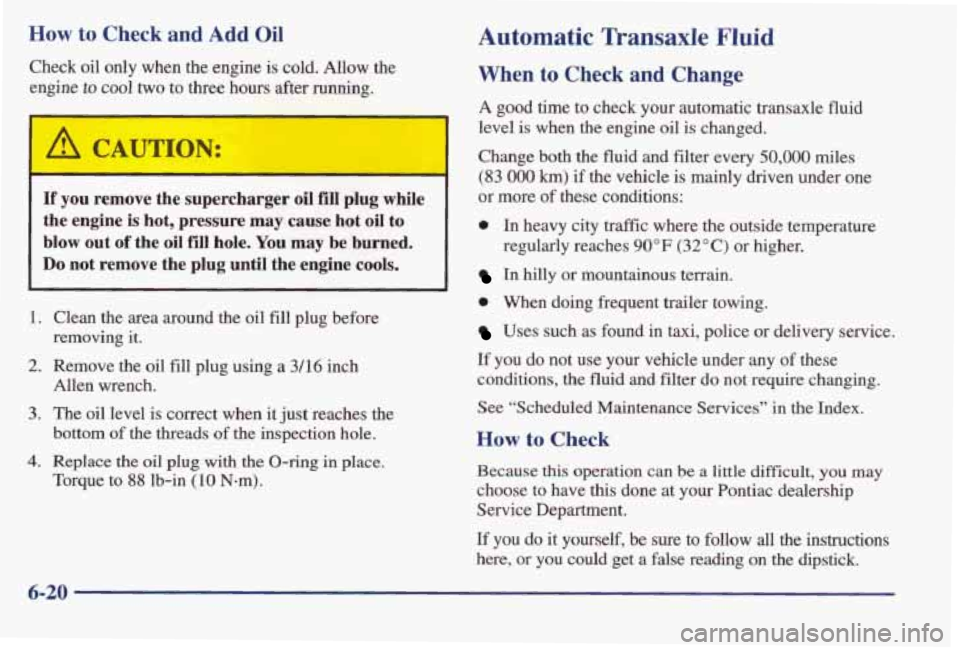
How to Check and Add Oil
Check oil only when the engine is cold. Allow the
engine
to cool two to three hours after running.
If you remove the supercharger oil €ill plug while
the engine
is hot, pressure may cause hot oil to
blow out
of the oil fill hole. You may be burned.
Do not remove the plug until the engine cools.
1. Clean the area around the oil fill plug before
2. Remove the oil fill plug using a 3/16 inch
3. The oil level is correct when it just reaches the
bottom of the threads of the inspection hole.
4. Replace the oil plug with the O-ring in place.
Torque to
88 lb-in (10 N-m).
removing it.
Allen wrench.
Automatic Transaxle Fluid
When to Check and Change
A good time to check your automatic transaxle fluid
level is when the engine oil
is changed.
Change both the fluid and filter every
50,000 miles
(83 000 km) if the vehicle is mainly driven under one
or more of these conditions:
0 In heavy city traflic where the outside temperature
regularly reaches
90°F (32°C) or higher.
In hilly or mountainous terrain.
0 When doing frequent trailer towing.
Uses such as found in taxi, police or delivery service.
If you do not use your vehicle under any of these
conditions, the fluid and filter do not require changing.
See “Scheduled Maintenance Services” in the Index.
How to Check
Because this operation can be a little difficult, you may
choose to have
this done at your Pontiac dealership
Service Department.
If you do it yourself, be sure to follow all the instructions
here, or you could get
a false reading on the dipstick.
6-20
Page 282 of 395
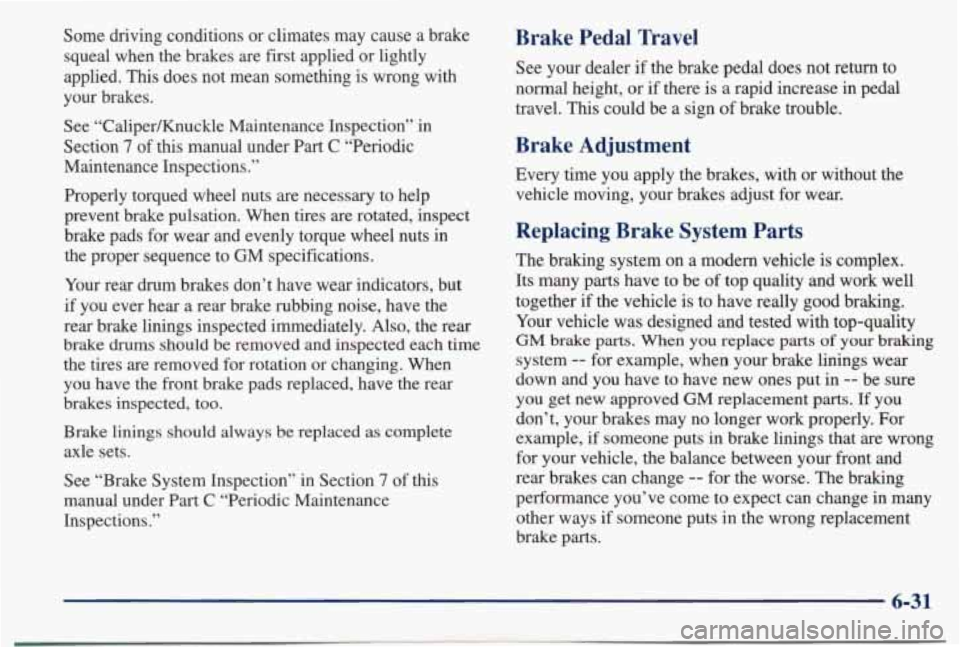
Some driving conditions or climates may cause a brake
squeal when the brakes are first applied or lightly
applied.
This does not mean something is wrong with
your brakes.
See “CaliperKnuckle Maintenance Inspection” in
Section
7 of this manual under Part C “Periodic
Maintenance Inspections.”
Properly torqued wheel nuts are necessary to help
prevent brake pulsation. When tires are rotated, inspect brake pads for wear and evenly torque wheel nuts in
the proper sequence to
GM specifications.
Your rear drum brakes don’t have wear indicators, but
if you ever hear a rear brake rubbing noise, have the
rear brake linings inspected immediately. Also, the rear
brake drums should be removed
and inspected each time
the tires are removed for rotation or changing. When
you have the front brake pads replaced, have the rear
brakes inspected, too.
Brake
linings should always be replaced as complete
axle sets.
See “Brake System Inspection” in Section
7 of this
manual under Part C “Periodic Maintenance
Inspections.”
Brake Pedal Travel
See your dealer if the brake pedal does not return to
normal height, or if there is
a rapid increase in pedal
travel.
This could be a sign of brake trouble.
Brake Adjustment
Every time you apply the brakes, with or without the
vehicle moving, your brakes adjust for wear.
Replacing Brake System Parts
The braking system on a modern vehicle is complex.
Its many parts have to be
of top quality and work well
together if the vehicle is to have really good braking. Your vehicle was designed and tested with top-quality
GM brake parts. When you replace parts of your braking
system -- for example, when your brake linings wear
down and you have to have new ones put
in -- be sure
you get new approved
GM replacement parts. If you
don’t, your brakes may no longer work properly. For example,
if someone puts in brake linings that are wrong
for your vehicle, the balance between your front and
rear brakes can change
-- for the worse. The braking
performance you’ve come to expect can change in many
other ways if someone puts in the wrong replacement
brake parts.
6-31
Page 294 of 395

Tire Inspection and Rotation
Tires should be rotated every 6,000 to 8,000 miles
(10 OOO to 13 OOO km). Any time you notice unusual
wear, rotate your tires as soon as possible and check
wheel alignment.
Also check for damaged tires or wheels.
See “When It’s Time for New Tires” and “Wheel
Replacement” later in
this section for more information.
The purpose of regular rotation is to achieve more
uniform wear for all tires on the vehicle. The first
rotation is the most important. See “Scheduled Maintenance Services” in the Index for scheduled
rotation intervals.
m4
Don’t include the compact spare tire in your tire rotation.
After the tires have been rotated, adjust the front
and rear inflation pressures as shown
on the
Tire-Loading Information label. Make certain that all wheel nuts
are properly tightened. See “Wheel
Nut Torque” in the Index.
A CAUTION:
Rust or dirt on a wheel, or on the parts to which
it is fastened, can make wheel nuts become loose
after a time. The wheel could come
off and cause
an accident. When you change a wheel, remove
any rust or dirt from places where the wheel
attaches to the vehicle. In an emergency, you can
use a cloth or
a paper towel to do this; but be
sure to use a scraper or wire brush later,
if you
need to, to get all the rust or dirt
off. (See
“Changing a Flat Tire” in the Index.)
I
When rotating your tires, always use the correct rotation
pattern shown here.
6-43
Page 316 of 395

Capacities and Specifications
The following approximate capacities are given in English and m\
etric conversions. Please refer to “Recommended
Fluids and Lubricants” in the Index for more information.
Automatic Transaxle (Overdrive)
Pan Removal and Replacement ........... 6 quarts (6.1 L)
Complete Overhaul .................. 11 quarts (10.4 L)
Cooling System ........................ 13 quarts (12.3 L)
When draining or replacing torque converter; more fluid may be needed.
Cooling System ................ ........ 13 quarts (12.3 L)
Engine Crankcase ................... 4.5 quarts (4.3L)
Fuel Tank ............................ 18 gallons (68 L)
Tire Pressures .... >.. . See Ere-Loading Information label on the driver’s dool:
Wheel Nut Torque ......... . 100 lb-ft 140 N-m
R-134a Air Conditioning .... . See refrigerant charge label under the hood.
Oil
change with filter change
.......
.......
.......
All capacities are approximate. When adding, be sure to fill to the appropriate level, as recommended in this manual.
Air Conditioning Refrigerants
Not all air conditioning refrigerants are the same. If the air conditioning system in your vehicle needs refrigerant, be
sure the proper refrigerant is used. If you’re not sure,
ask your dealer.
6-65
Page 384 of 395
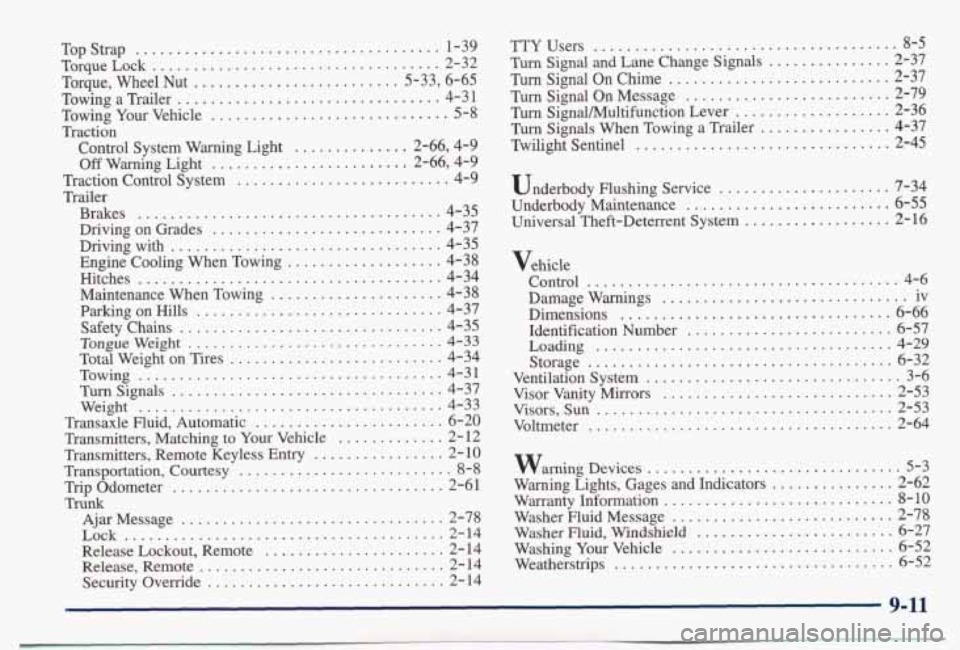
TopStrap ................................... 1-39
TorqueLock ................................... 2-32
Torque, Wheel Nut ......................... 5-33, 6-65
Towing a Trailer ................................ 4-31
Towing Your Vehicle ............................. 5-8
Control System Warning Light ............ 2-66, 4-9
Off Warning Light ........................ 2-66, 4-9
Traction Control Svstem .......................... 4-9
Traction
I
Trailer
Brakes
................................... 4-35
Driving with ................................. 4-35
Engine Cooling When Towing ................... 4-38
Maintenance When Towing ..................... 4-38
Parking on Hills .............................. 4-37
Safety Chains ................................ 4-35
Total Weight on Tires .......................... 4-34
Turn Signals ................................. 4-37
Transaxle Fluid, Automatic ....................... 6-20
Transmitters, Matching to Your Vehicle ............. 2- 12
Transmitters, Remote Keyless Entry ................ 2-10
Transportation, Courtesy .......................... 8-8
Trip Odometer ................................. 2-61
Ajar Message ................................ 2-78
Release Lockout, Remote ...................... 2-14
Release, Remote .............................. 2-14
Driving on Grades ........... ............ 4-37
Hitches ..................................... 4-34
Tongueweight ............................... 4-33
Towing ..................................... 4-31
Weight ..................................... 4-33
Trunk
Lock ....................................... 2-14
SecurityOverride ............................. 2-14
TTY Users ..................................... 8-5
Turn Signal and Lane Change Signals ............... 2-37
Turn Signal On Chime ........................... 2-37
Turn Signal On Message ......................... 2-79
Turn Signal/Multifunction Lever ................... 2-36
Turn Signals When Towing a Trailer ................ 4-37
"light Sentinel ............................... 2-45
Underbody Flushing Service ..................... 7-34
Underbody Maintenance ......................... 6-55
Universal Theft-Deterrent System .................. 2-16
Vehicle
Control
...................................... 4-6
Damage Warnings .............................. iv
Dimensions
................................. 6-66
Identification Number ......................... 6-57
Loading .................................... 4-29
Storage ..................................... 6-32
Ventilationsystem ............................... 3-6
Visor Vanity Mirrors ............................ 2-53
Visors, Sun .................................... 2-53
Voltmeter ..................................... 2-64
warning Devices ............................... 5-3
Warning Lights. Gages and Indicators ............... 2-62
Warranty Information ............................ 8-10
Washer Fluid Message ........................... 2-78
Washer muid. Windshield ........................ 6-27
Washing Your Vehicle ........................... 6-52
Weatherstrips .................................. 6-52
9-11
Page 385 of 395
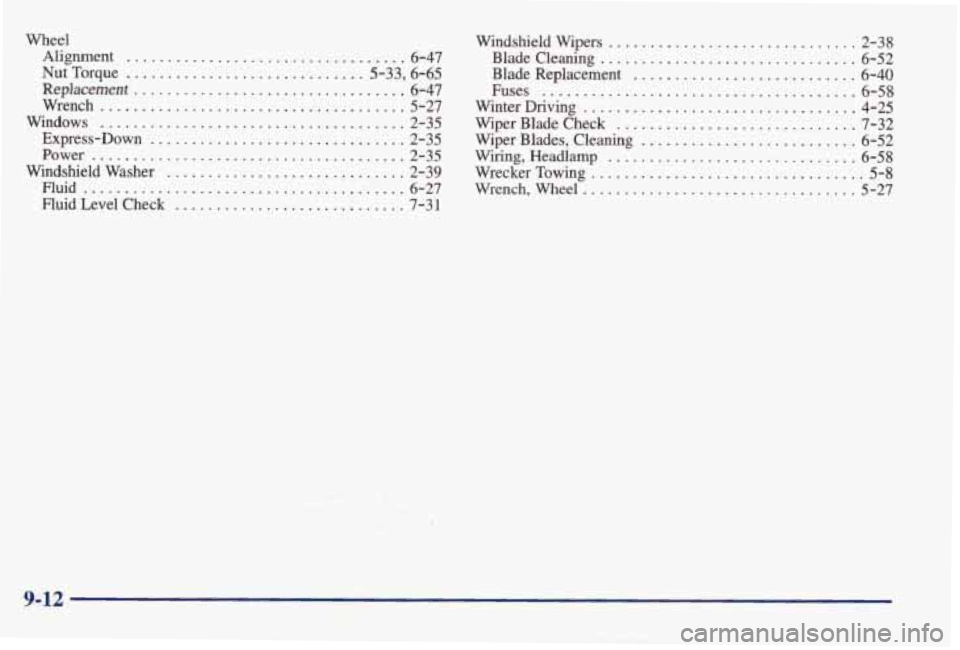
Wheel Alignment
.................................. 6-47
Nut Torque ............................. 5-33, 6-65
Replacement ................................. 6-47
Wrench ..................................... 5-27
Express-Down ............................... 2-35
Windshield Washer ............................. 2-39
Fluid Level Check ............................ 7-31
Windows ..................................... 2-35
Power ...................................... 2-35
Fluid ....................................... 6-27
Windshield Wipers .............................. 2-38
Blade Replacement ........................... 6-40
Winter Driving ................................. 4-25
Wiper Blade Check ............................. 7-32
Wiper Blades, Cleaning .......................... 6-52
Wiring, Headlamp .............................. 6-58
Wrecker Towing ................................. 5-8
Wrench, Wheel ................................. 5-27
Bladecleaning ............................... 6-52
Fuses ...................................... 6-58
9-12